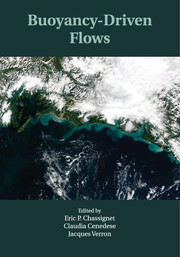Book contents
- Frontmatter
- Contents
- List of Contributors
- Introduction
- 1 Gravity currents – theory and laboratory experiments
- 2 Theory of oceanic buoyancy-driven flows
- 3 Buoyancy-forced circulation and downwelling in marginal seas
- 4 Buoyant coastal currents
- 5 Overflows and convectively driven flows
- 6 An ocean climate modeling perspective on buoyancy-driven flows
- 7 Buoyancy-driven currents in eddying ocean models
- 8 Atmospheric buoyancy-driven flows
- 9 Volcanic flows
- 10 Gravity flow on steep slope
- Index
- Plate section
- References
10 - Gravity flow on steep slope
Published online by Cambridge University Press: 05 April 2012
- Frontmatter
- Contents
- List of Contributors
- Introduction
- 1 Gravity currents – theory and laboratory experiments
- 2 Theory of oceanic buoyancy-driven flows
- 3 Buoyancy-forced circulation and downwelling in marginal seas
- 4 Buoyant coastal currents
- 5 Overflows and convectively driven flows
- 6 An ocean climate modeling perspective on buoyancy-driven flows
- 7 Buoyancy-driven currents in eddying ocean models
- 8 Atmospheric buoyancy-driven flows
- 9 Volcanic flows
- 10 Gravity flow on steep slope
- Index
- Plate section
- References
Summary
Introduction
Particle-laden, gravity-driven flows occur in a large variety of natural and industrial situations. Typical examples include turbidity currents, volcanic eruptions, and sand-storms (see Simpson 1997 for a review). On mountain slopes, debris flows and snow avalanches provide particular instances of vigorous dense flows, which have special features that make them different from usual gravity currents. Those special features include the following:
They belong to the class of non-Boussinesq flows since the density difference between the ambient fluid and the flow is usually very large, whereas most gravity currents are generated by a density difference of a few percent.
Whereas many gravity currents are driven by pressure gradient and buoyancy forces, the dynamics of flows on slope are controlled by the balance between the gravitational acceleration and dissipation forces. Understanding the rheological behavior of particle suspensions is often of paramount importance when studying gravity flows on steep slope.
This chapter reviews some of the essential features of snow avalanches and debris flows. Since these flows are a major threat to human activities in mountain areas, they have been studied since the late 19th century. In spite of the huge amount of work done in collecting field data and developing flow-dynamics models, there remain great challenges in understanding the dynamics of flows on steep slope and, ultimately, in predicting their occurrence and behavior. Indeed, these flows involve a number of complications such as abrupt surge fronts, varying free and basal surfaces, and flow structure that changes with position and time.
- Type
- Chapter
- Information
- Buoyancy-Driven Flows , pp. 372 - 432Publisher: Cambridge University PressPrint publication year: 2012
References
- 4
- Cited by



